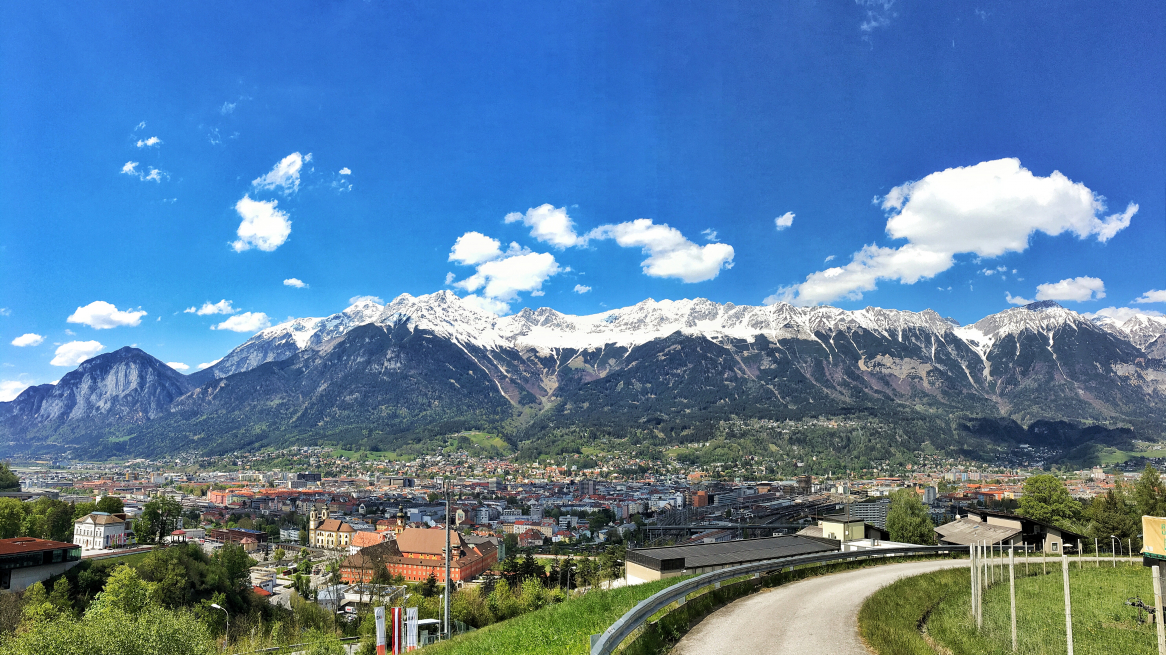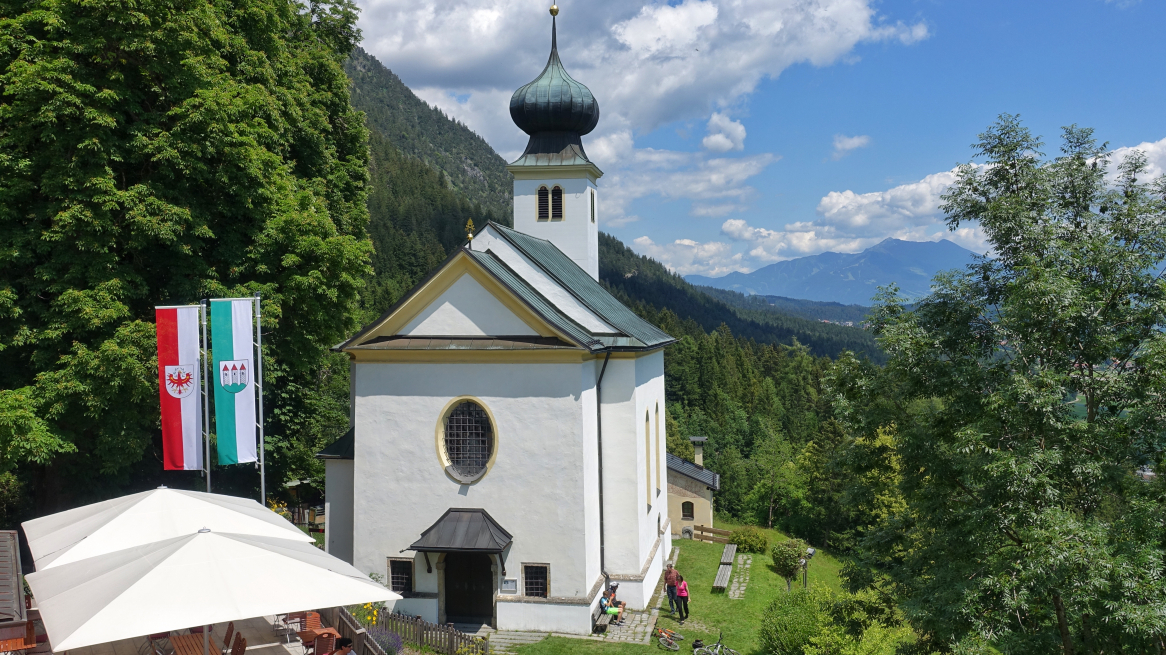
In the late Middle Ages, hundreds of thousands of pilgrims passed through Innsbruck. Today, our city still represents a crossroads of the three most famous pilgrimage routes of Christianity. The Jerusalem Way, the Way to Rome and the Way of St. James to Santiago de Compostela meet here.
"To Jerusalem one walks to find Jesus, to Rome one goes to the Pope, but on the path to Santiago de Compostela one searches for oneself." This Spanish proverb expresses the diversity that drives modern pilgrims as they scatter from Innsbruck in three cardinal directions. The west is the direction to Santiago. The south is the direction to Rome, and the Jerusalem route goes east.
Coming from the east on the Way of St. James, pilgrims pass the beautiful Gnadenwald with its St. Martin's Church. Picture: W. Kräutler
On their way from Brenner to Innsbruck pilgrims walk towards the grandiose Nordkette and thus Innsbruck. Here the Way of St. James near Patsch. Picture: W. Kräutler
There is a simple reason why millions of Christians in the Middle Ages went on pilgrimages, which were extremely dangerous at the time. The fear of eternal damnation drove them to reach Santiago de Compostela in particular. Since the Catholic Church granted a 'plenary indulgence' to those pilgrims who reached the tomb of St. James the Apostle in Santiago, millions undertook the arduous and highly dangerous tour across Europe. The prospect of escaping 'eternal damnation' through pilgrimage was too tempting.
One of the oldest pilgrim graffiti in Tyrol dates from 1604. Using red chalk, a medieval pilgrim immortalized himself in the church at Obsaurs in the Tyrolean Oberland. Image: W. Kräutler
Hardly imaginable today: On their way to Santiago de Compostela, Rome or Jerusalem, hundreds of thousands of pilgrims stopped in Innsbruck. At the end of the Middle Ages, it was the image of Mary Help of Christians by the great Gothic master Lucas Cranach the Elder in the Cathedral of St. James in Innsbruck that caused an additional rush of devout pilgrims.
The 'Gnadenbild Mariahilf' by Lucas Cranach the Elder in the cathedral of Innsbruck was the destination of hundreds of thousands of pilgrims. Image: W. Kräutler
Today highly topical again: the Way of St. James
Just imagine: in 2022, more than 438,000 pilgrims arrived in Santiago de Compostela. 20 years earlier, there were barely 60,000. Why this dramatic increase? My experiences walking from Rietz via Santiago to the end of the world in 2022 produced a 'collective result', so to speak: it is the search for the meaning of one's own life that drives young people in particular once again to cover great distances without a motorized vehicle.
On their way through Austria, pilgrims of St. James pass Innsbruck coming from two directions at once, on the one hand from the east, when the pilgrims arrive in Innsbruck coming from Gnadenwald. I have described the last stage before Innsbruck here. Those who have overcome the Brenner pass meet the pilgrims from Inner Austria here.
Shortly before Innsbruck, pilgrims of St. James enjoy village beauty like here in Arzl. Picture: W. Kräutler
It was mainly South Tyrolean pilgrims whose way led over the Brenner Pass and Innsbruck in the past centuries. On the one hand, because of the image of grace in the cathedral of St. Jacob, on the other hand, it was and is the 'Black Madonna' of Einsiedeln, which has always exerted a magical attraction on Tyrolean believers. The way to her leads via Innsbruck and the Arlberg. I have described the section between Brenner and Innsbruck here.
The 'Black Madonna' of Einsiedeln in Switzerland is still the destination of many Tyrolean pilgrims today. Image: W. Kräutler
The Romedius Way
The pilgrimage churches in the vicinity of Innsbruck have always provided all kinds of religious entertainment. The Romedius Church in Thaur commemorates the work of St. Romed, who, according to legend, had been active there. The beautifully situated little church is also the starting point of the Romediusweg, a path created a few years ago that connects the two Romedius memorial places: Thaur and San Romedio.
The Romedius Church above Thaur is the starting point of a pilgrimage trail that would do honor to an alpine long-distance hike: the Romediusweg. Image: W. Kräutler
This pilgrimage trail is certainly one of the most challenging pilgrimage trails in Tyrol. It leads along ancient paths via Mieders and Maria Waldrast into the Gschnitztal valley. There you cross a yoke into the Obernberger valley and hike along the Obernberger lake to the Portjoch, where you cross the border to South Tyrol. After twelve stages you reach San Romedio. A wonderful tour description can be downloaded from the web.
Quo Vadis: the pilgrimage route from Innsbruck to Maria Waldrast
An integral part of Tyrolean piety is Maria Waldrast above Matrei am Brenner. This place is especially known and loved for its miraculous water. Less known is that above the monastery church at the transition between Wipp and Stubaital once stood a stone circle. If you look closely, you can still recognize the stones as a barrier and under the grass and peat cover. In any case, they are signs that this place must have been a kind of pilgrimage site already in prehistoric times.
Maria Waldrast, an ancient pilgrimage site that certainly existed in pre-Christian times. Image: W. Kräutler
At the transition from the Wipptal to the Stubai once stood a stone circle. Today, its components serve as path boundaries. Image. W. Kräutler
Quo Vadis is the name of this one-day pilgrimage route that follows the footsteps of Bishop Reinhold Stecher. He had mastered this route countless times alone in the early morning.
Maria Locherboden
The pilgrimage church of Maria Locherboden is similar. It is located about 30 kilometers west of Innsbruck and is also one of the places of power that is still much visited today. It, too, stands on a historic cult mound, near which Bronze Age buildings were found during excavations. Today's pilgrimage church is not only located on the Tyrolean Way of St. James from Innsbruck to Stams Abbey in the Upper Inn Valley, it is also reached by pilgrims walking the Isar-Loisach-Leutascherache-Inn Way of St. James between Munich and Stams.
The Via Romea: from Stade to Rome
The VIA ROMEA of Abbot Albert of Stade is not to be confused with the Via Francigena, currently the most famous pilgrimage route to the eternal city. The VIA ROMEA runs pretty much vertically from Stade to the south via Austria and the Brenner Pass and only meets the Via Francigena on the last section west of Viterbo.
The VIA ROMEA leads via Scharnitz, Seefeld and Reith to Innsbruck - and of course further over the Brenner Pass to Rome. Picture: W. Kräutler
Coming from Scharnitz, the pilgrims approach the provincial capital via Seefeld and Reith. From there the path continues via Igls, Matrei, Steinach and Gries to the Brenner Pass.
The earlier imponderables on the pilgrimage route between Innsbruck and Rome have diminished since the publication of a very good pilgrimage guide. Ferdinand Tremel, for a long time chairman of the Jakobsgemeinschaft Tirol, has described the route from Innsbruck via Bolzano, Padua, Bologna and Assisi to Rome in detail and well.
The route from Innsbruck to the Brenner Pass runs along the Roman army road suspected there via Patsch and Ellbögen to Matrei. Via Steinach and Gries am Brenner pilgrims reach the Brenner Pass.
The Jerusalem Way
The pilgrimage to Jerusalem is certainly one of the most exciting walks. It is certainly one of the longest pilgrimage routes, as there are about 4,600 kilometers between Innsbruck and Jersusalem alone. From Innsbruck it leads via Vienna and Budapest through the Balkans to Istanbul. The route via Damascus in Syria is not passable due to the war. The suggestion is to travel by plane from Antalya to Amman and then tackle the final stages to Jerusalem. Information is available on the corresponding website.
With my two French pilgrim friends in 2022 on the last stage of the way from Rietz to Finisterre. In the background: the 'end of the world'. Image: W. Kräutler
Why I walk through Europe on pilgrimage?
For me, pilgrimage means, on the one hand, getting to know Europe's cultural heritage up close, and on the other, reviving an ancient way of traveling that Johann Wolfgang von Goethe once described thus: "Only where you have been on foot have you really been." Not to mention the beauties that await seekers along the pilgrimage routes.
With this in mind, I wish all readers: Buen Camino!
Useful and interesting links for pilgrims and those who want to become pilgrims:
My website on the Tyrolean Way of St. James: https://tirolerjakobsweg.wordpress.com/
The course of the Way of St. James through Tyrol: https://www.tirol.at/reisefuehrer/sport/wandern/wandertouren/a-jakobsweg
The Romediusweg from Thaur to San Romedio: https://www.romedius-pilgerweg.at/
Quo Vadisweg to Maria Waldrast https://www.quovadis-tirol.com/at/pilgerweg.php
The way of the abbot Stade to Rome: https://www.viaromea.de/pilgerweg/gesamtstrecke/
The way from Innsbruck to Rome: https://www.pilgerweg-nach-rom.at/Galerie
The book about the pilgrimage to Rome: https://www.pilgerweg-nach-rom.at/
The Jerusalem Way: https://www.jerusalemway.org/route/oesterreich/
Rate this article
Show me the location on the map
A volunteer at the "Schule der Alm" alpine farming school, cultural pilgrim, Tyrol aficionado and Innsbruck fan.
Similar articles
The 'Path of the Senses' from Rietz via Stams to Mötz-Locherboden is an exploration in the…
The museum in Innsbruck's Arsenal "Museum im Zeughaus" was reopened on April 6,…
The Ferdinandeum regional museum is open until June 30, 2024, with exhibitions and events. Then a…
A purely Tyrolean film project aims to shed new light on the novel story of probably…





















